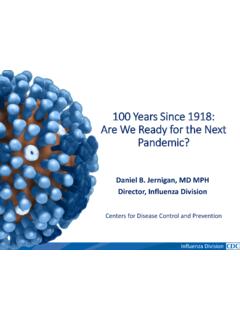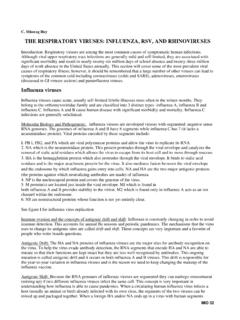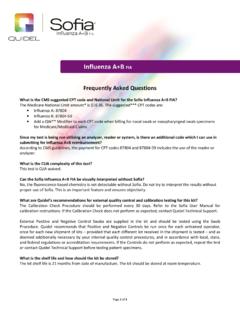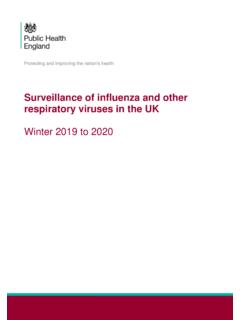Transcription of National Strategy for pandemic influenza
1 National Strategy for pandemic influenza implementation plan homeland security council may 2006 36014p1_08 4/29/06 3:53 PM Page iNational Strategy for pandemic influenza implementation plan homeland security council may 2006 36014p1_08 4/29/06 3:53 PM Page iii36014p1_08 4/29/06 3:53 PM Page vTable of Contents PREFACE ..vii CHAPTER 1 - EXECUTIVE THE pandemic THREAT ..1 CHAPTER 2 - GOVERNMENT PLANNING FOR A pandemic ..1 CHAPTER 3 - FEDERAL GOVERNMENT RESPONSE TO A pandemic ..2 CHAPTER 4 - INTERNATIONAL EFFORTS ..4 CHAPTER 5 - TRANSPORTATION AND CHAPTER 6 - PROTECTING HUMAN HEALTH ..8 CHAPTER 7 - PROTECTING ANIMAL HEALTH ..10 CHAPTER 8 - LAW ENFORCEMENT, PUBLIC SAFETY, AND SECURITY.
2 12 CHAPTER 9 - INSTITUTIONS: PROTECTING PERSONNEL AND ENSURING CONTINUITY OF CHAPTER 2 - GOVERNMENT PLANNING FOR A THE pandemic THREAT ..15 THE National Strategy FOR pandemic IMPLEMENTATION OF THE National NECESSARY ENABLERS OF pandemic ADVANCING pandemic PLANNING ASSUMPTIONS ..25 CHAPTER 3 - FEDERAL GOVERNMENT RESPONSE TO A pandemic ..27 COMMAND, CONTROL, AND COORDINATION OF THE FEDERAL RESPONSE ..27 ROLES AND FEDERAL GOVERNMENT ACTIONS DURING A pandemic ..30 SUMMARY OF FEDERAL GOVERNMENT ACTIONS DURING A CHAPTER 4 - INTERNATIONAL EFFORTS ..43 INTRODUCTION ..43 KEY ROLES AND ACTIONS AND CHAPTER 5 - TRANSPORTATION AND BORDERS.
3 71 INTRODUCTION ..71 KEY ROLES AND ACTIONS AND CHAPTER 6 - PROTECTING HUMAN HEALTH ..99 INTRODUCTION ..99 KEY ROLES AND ACTIONS AND Implementation Plan for the National Strategy for pandemic influenza v 36014p1_08 4/29/06 3:53 PM Page viCHAPTER 7 - PROTECTING ANIMAL HEALTH ..137 INTRODUCTION ..137 KEY ROLES AND ACTIONS AND CHAPTER 8 - LAW ENFORCEMENT, PUBLIC SAFETY, AND SECURITY ..153 INTRODUCTION ..153 KEY ROLES AND ACTIONS AND CHAPTER 9 - INSTITUTIONS: PROTECTING PERSONNEL AND ENSURING CONTINUITY OF OPERATIONS ..165 INTRODUCTION ..165 KEY ROLES AND ACTIONS AND APPENDIX A ..181 GUIDANCE FOR FEDERAL DEPARTMENT PLANNING.
4 181 GUIDANCE FOR ORGANIZATIONS AND BUSINESSES ..182 GUIDANCE FOR SCHOOLS (K-12) ..185 GUIDANCE FOR COLLEGES AND GUIDANCE FOR FAITH-BASED AND COMMUNITY-BASED ORGANIZATIONS ..191 PLANNING GUIDANCE FOR INDIVIDUALS AND APPENDIX B ..201 GLOSSARY OF Acronyms ..201 Definition of APPENDIX C ..211 AUTHORITIES AND REFERENCES ..211 Chapter 2 - Government Planning for a Chapter 3 - Federal Government Response to a pandemic ..211 Chapter 4 - International Chapter 5 - Transportation and Borders ..215 Chapter 6 - Protecting Human Chapter 7 - Protecting Animal Health ..222 Chapter 8 - Law Enforcement, Public Safety, and Chapter 9 - Institutions: Protecting Personnel and Ensuring Continuity of vi Implementation Plan for the National Strategy for pandemic influenza 36014p1_08 4/29/06 3:53 PM Page viiPreface In the last century, three influenza pandemics have swept the globe.
5 In 1918, the first pandemic (some times referred to as the Spanish Flu ) killed over 500,000 Americans and more than 20 million people worldwide. One-third of the population was infected, and average life expectancy was reduced by 13 years. Pandemics in 1957 and 1968 killed tens of thousands of Americans and millions across the world. Scientists believe that viruses from birds played a role in each of those outbreaks. Today, we face a new threat. A new influenza strain influenza A (H5N1) is spreading through bird populations across Asia, Africa, and Europe, infecting domesticated birds, including ducks and chickens, and long-range migratory birds.
6 The first recorded appearance of H5N1 in humans occurred in Hong Kong in 1997. Since then, the virus has infected over 200 people in the Eastern Hemisphere, with a mortality rate of over 50 percent. At this time, avian influenza is primarily an animal disease. Human infections are generally limited to individuals who come into direct contact with infected birds. If the virus develops the capacity for sustained, efficient, human-to-human transmission, however, it could spread quickly around the globe. In response to this threat, the President issued the National Strategy for pandemic influenza on November 1, 2005. The Strategy outlines the coordinated Federal Government effort to prepare for pandemic influenza .
7 Of equal importance, the Strategy underscores the critical roles that State, local, and tribal authorities, the private sector, and communities must play to address the threat of a pandemic , and the concrete steps that individuals can and should take to protect themselves and their families. This Implementation Plan for the National Strategy for pandemic influenza further clarifies the roles and responsibilities of governmental and non-governmental entities, including Federal, State, local, and tribal authorities and regional, National , and international stakeholders, and provides preparedness guidance for all segments of society. The Plan addresses the following topics: Chapters 2 and 3 ( Government Planning and Response) describe the unique threat posed by a pandemic that would spread across the globe over a period of many months; the specific and coordi nated actions to be taken by the Federal Government as well as its capabilities and limitations in responding to the sustained and distributed burden of a pandemic ; and the central importance of comprehensive preparation at the State, local, and community levels to address medical and non medical impacts with available resources.
8 Chapters 4 and 5 (International Efforts and Transportation and Borders) outline steps we will take to work with our international partners to prevent, slow, or limit the spread of infection globally and in the United States, and describe proposed measures for effective management of our borders and the transportation sector during a pandemic . Chapter 6 (Protecting Human Health) details the critical actions that public health authorities, non governmental organizations, the private sector, and individuals should take to protect human health and reduce the morbidity and mortality caused by a pandemic . Chapter 7 (Protecting Animal Health) highlights the actions necessary to prevent and contain outbreaks in animals with the aim of reducing human exposure and the opportunity for viral mutation that could result in efficient human-to-human transmission.
9 Implementation Plan for the National Strategy for pandemic influenza vii 36014p1_08 4/29/06 3:53 PM Page viiiPreface Chapter 8 (Law Enforcement, Public Safety, and Security) outlines the support that State and local law enforcement and public safety agencies must provide, with appropriate Federal assistance, to public health efforts and essential public safety services, and to maintain public order. Chapter 9 (Institutional Considerations) provides guidance for the preparation of essential pandemic plans by Federal, State, local, and tribal authorities, businesses, schools, and non-governmental organi zations to ensure continuity of operations and maintenance of critical infrastructure.
10 It also provides guidance for families and individuals to ensure appropriate personal protection. To address the threat of pandemic influenza , it is essential that such plans be put in place as soon as possible. The Implementation Plan represents a comprehensive effort by the Federal Government to identify the critical steps that must be taken immediately and over the coming months and years to address the threat of an influenza pandemic . It assigns specific responsibilities to Departments and Agencies across the Federal Government, and includes measures of progress and timelines for implementation to ensure that we meet our preparedness objectives.













